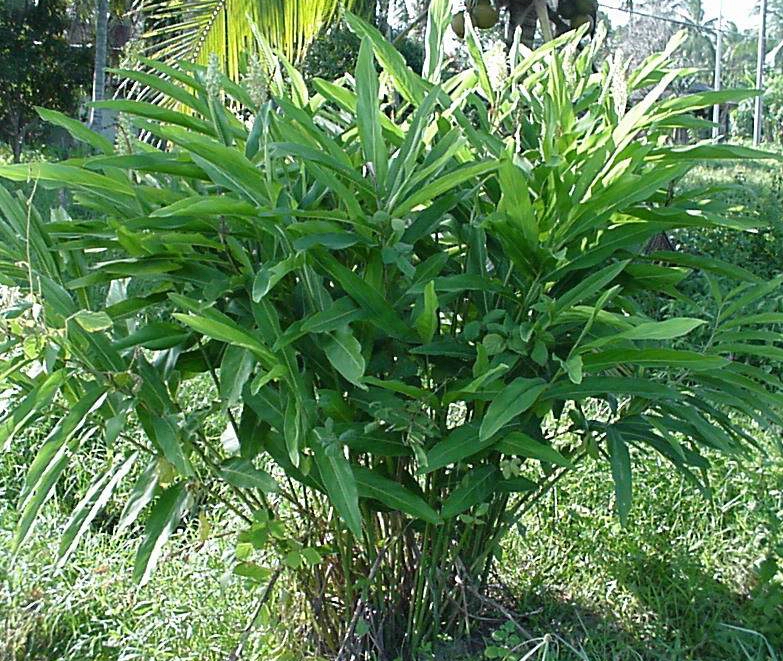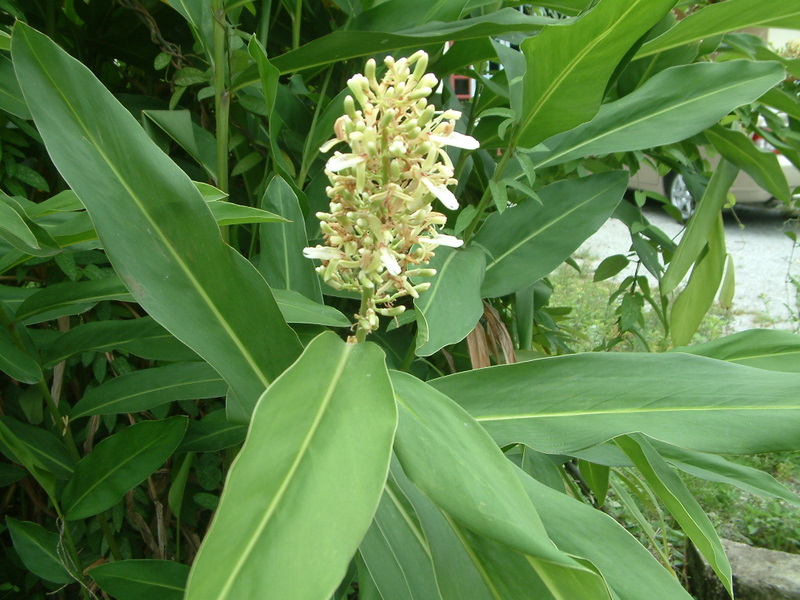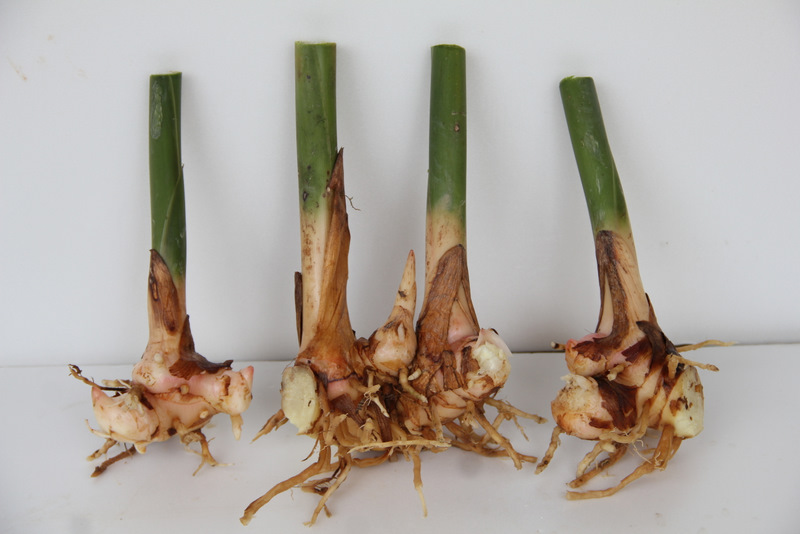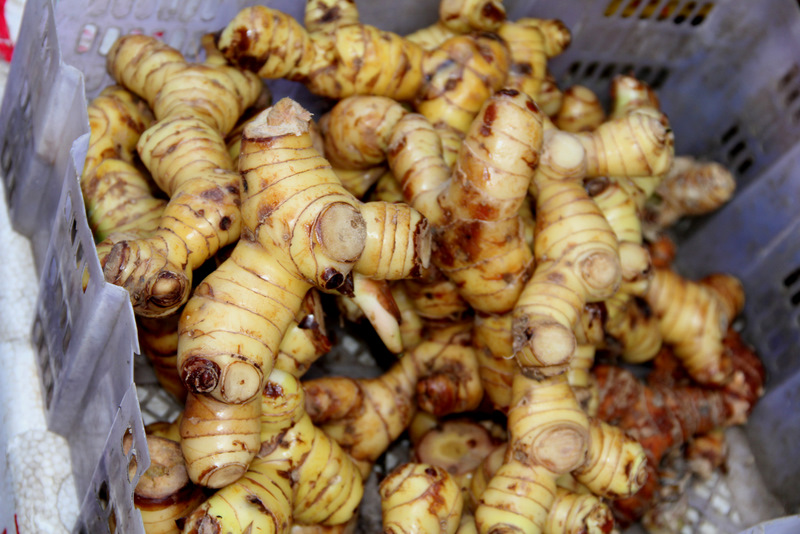Botanical Names
Alpinia galanga (L). Wild
Common Names
| Malaysia | Lengkuas, puar |
| English | Galanga, greater galanga |
| Indonesia | Langkuas, laos (Javanese), laja (Sundanese) |
| Thailand | Kha, kha yuak (northern), katuk karohinea (central) |
Family
Zingiberaceae
Introduction
‘Lengkuas’ is a tropical plant and native to South East Asia countries, including India and China. It is now being found most tropical and subtropical regions of the world. Traditionally the plant is planted in small herbal garden plots in rather wet ground with high organic matter content. More recently it has been planted commercially in United Stated of America, India and South East Asia.[1]

Morphological Features
‘Lengkuas’ is a perennial herb. The plant grows from rhizomes in clumps of stalks up to two meters in height. The leaves are glossy green, oblong lanceolate in shape, measuring about 50 cm wide, 9 cm in width and 50 cm long. The inflorescence is raceme like, erect and whitish pink or light yellow in colour. The rhizomes are red in colour and have a very sharp sweet smell.[1]


Medicinal Properties and Usage
In Malaysia, ‘lengkuas’ are normally used as a spice for flavouring foods. It is also used as the ingredient in some herbal preparations. The rhizomes have an anti bacterial and digestive stimulant properties. Thus it decoctions are normally used to treat flatulence, dyspepsia, vomiting and stomach bloating. The poultice of the rhizomes that were mixed with vinegar is used to treat eczema. The leaves are used as ingredients in afterbirth herbal bath. The dried powdered rhizomes are taken with water to treat nausea due to motion sickness during air and sea travel.[1][2][3]
Soil Suitability and Climatic Requirement
The plant is very hardy and is adaptable to various soil types from the lowland to the upland areas with temperatures ranging from 25-35oC. However it is best suited to well-drained soil with high organic matter and the annual rainfall of 200–300 cm. The plants perform better in open areas with full sunlight.[1]
Field Preparation
Land Preparation
The planting area must be rotovated to improve the soil structure and eliminate the weeds. The first rotovation is also done to prepare the area for liming activity if the pH of the area is low (acid soil). The second ploughing must be carried out after application of the liming material to ensure the material is well incorporated into the soil to obtain the optimum effect.[1]
Production of Planting Materials
‘Lengkuas’ can be propagated using its rhizomes. To ensure that it will germinates, the matured rhizomes having 2 to 3 growing points and some roots are used. The mature rhizomes are bright red in colour with profusely active growing roots. The plant is very hardy and the fresh rhizomes can be directly planted to the field.[1]

Field Planting
The canopy diameter of a fully-grown lengkuas is about 1.5 m wide. Thus the recommended planting distance is about 1.0 m between rows and 1.0 m within plants in a row. This will give the population density of about 10,000 plants per ha. Planting should be done at the beginning of the planting seasons to minimise the transplanting shock. The rhizomes should be planted to about 4-6 cm deep into the planting hole measuring about 20 cm X 20 cm X 20 cm. Organic mulch such as dried leaves can be applied to conserve the soil moisture.[1]
Field Maintenance
Fertilisation
The fertilisers that are recommended for lengkuas are organic fertiliser (chicken dung), urea and compound fertiliser (NPK=12:12:17:2). Chicken dung should be given at the rate of 200 g per planting point 3-5 days before planting. Urea should be at 1 and 4 months after planting at the rate of 65 kg/ha. NPK compound fertiliser at the rate of 500 kg/ha should be given at 7 and 10 months after planting.[1]
Weed Control
Weeds should be controlled only during the early part of the crop growth (after 4 and 7 months) manually by using grass cutter or contact herbicides. The dense canopy of the crop will naturally control the weeds when it is full-grown.[1]
Water Management
‘Lengkuas’ is very hardy. Thus no irrigation is required for field planting. However, to avoid transplanting stress, planting should be carried out at the beginning of the rainy seasons.[1]
Pest and Disease Control
Currently, there are no serious pest and disease problems on the field planting of ‘lengkuas’.[1]
Harvesting
Depending on the soil fertility, ‘lengkuas’ reach its maturity at about 10-12 months after planting. At this growth stage, the plant starts to produce flowers. The rhizomes are harvested manually by using hoe. The harvested rhizomes are cut from the stems. The estimated yield is about 6 kg/clump (60 t/ha).[1]
Postharvest Handling
Harvested rhizomes are washed and dried at air temperature and sold as fresh rhizomes. The root hairs found on the rhizomes should be removed. The rhizomes are sliced into small pieces and dried for long-term storage and herbal preparations.[1]

Estimated Cost Of Production
The estimated cost of production per hectare of ‘lengkuas’ is RM20,000. Based on 60t/ha rhizome yield, the production cost is estimated to be RM 0.30/kg. The production cost was estimated based on the cost of current inputs during writing of this article.[1]
Read More
References
- Anon 2010. Kertas maklumat penanaman lengkuas. Kuala Lumpur : Department of Agriculture Peninsular Malaysia (unpublished)
- Anon. 2002. Compendium of Medicinal Plants Used in Malaysia (Vol. 2). Kuala Lumpur : HMRC-IMR
- Musa, Y., Azimah, K. and Zaharah, H. 2009. Tumbuhan Ubatan Popular Malaysia. Serdang : MARDI


